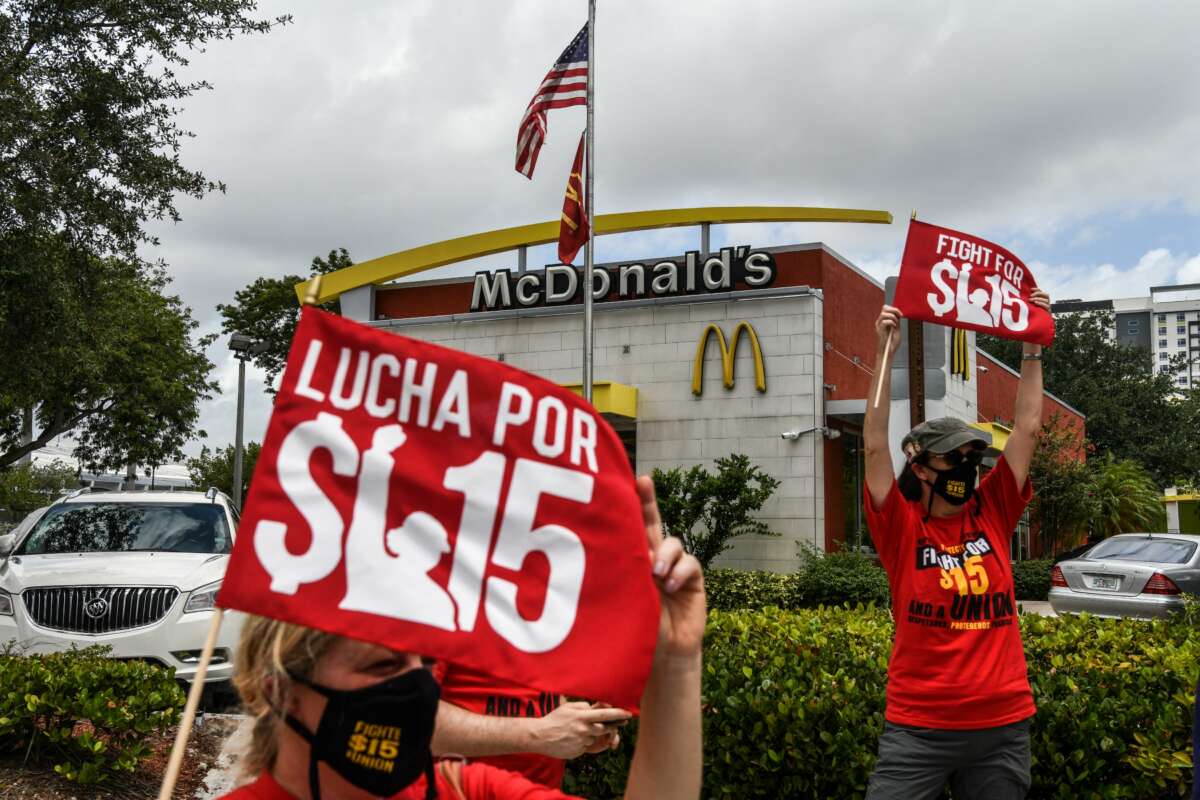A working paper unveiled this week by researchers at the University of California, Berkeley shows that large minimum wage increases can have positive effects on both earnings and employment, countering the notion pushed by corporate lobbying groups that significant wage hikes are job killers.
Examining nearly 50 large U.S. counties in California and New York whose wage floors reached $15 or higher by the first quarter of last year, the analysis found that sizable minimum wage hikes produced “substantial pay growth, no disemployment effects, and reduced wage inequality.”
The paper — authored by Justin Wiltshire, Carl McPherson, and Michael Reich — also found that when excluding counties with already-high minimum wages relative to other local areas, minimum wage increases actually boost employment.
Citing previous research on the impacts of local minimum wage hikes, the authors explain that “cities that enact local minimum wage increases tend to already have higher wages.”
“In other words, the local areas that enact their own minimum wage policies are less likely to experience employment effects (in either direction),” the paper notes. “Moreover, including high-wage labor markets — where the minimum wage has less bite — in treatment samples could also attenuate estimated effects.”
The researchers found “larger positive and significant” employment effects of minimum wage hikes when leaving out areas that already had higher average wages — indicating that large wage boosts in areas with lower minimum wages are beneficial for job growth.
The working paper comes as Sen. Bernie Sanders (I-Vermont) is preparing to introduce legislation Thursday that would raise the federal minimum wage to $17 an hour, up from the $7.25 level that it has been stuck at for more than a decade. According to the Economic Policy Institute, the federal minimum wage — which 15 U.S. states currently use as their wage floor — is worth 17% less today than it was 10 years ago.
“There are millions of workers in this country who are working literally on starvation wages, eight nine, ten bucks an hour,” Sanders told Insider on Wednesday. “Two years ago, we proposed a $15 an hour minimum wage as a result of inflation. $15 is now the equivalent of $17.”
When Sanders attempted to attach a $15 minimum wage amendment to a coronavirus relief package in 2021, eight members of the Senate Democratic caucus joined Republicans to block the effort.
“I think all over this country, you’re seeing states on their own voting to raise the minimum wage,” Sanders said Wednesday. “We have not raised the minimum wage here in Congress.”
In the absence of federal action, a record number of U.S. jurisdictions are set to raise their minimum wages in 2023 — in many cases above $15 an hour.
The new working paper focused primarily on fast food workers in 25 California counties and 22 New York counties that “are representative of the U.S as a whole: the distribution of average county wages in 42 of these counties lies uniformly between the 10th and 90th percentiles of all U.S. counties.”
“This pattern implies our results are generalizable to jurisdictions across the U.S.,” the authors note.
The analysis of wage hikes in the full 47-county sample found “positive and significant” impacts on worker earnings — particularly at the lower end of the wage distribution — and “positive and borderline-significant” effects on employment. When stripping from the sample counties that already had higher wage floors, “our positive employment estimates increase in magnitude and become significant,” the authors wrote.
“Our paper demonstrates that the rapid growth of minimum wages to high levels in California and New York resulted in increased earnings without causing negative employment effects,” they concluded. “Indeed, our evidence suggests that these minimum wage increases resulted in employment gains.”
4 Days Left: All gifts to Truthout now matched!
From now until the end of the year, all donations to Truthout will be matched dollar for dollar up to $44,000! Thanks to a generous supporter, your one-time gift today will be matched immediately. As well, your monthly donation will be matched for the whole first year, doubling your impact.
We have just 4 days left to raise $44,000 and receive the full match.
This matching gift comes at a critical time. As Trump attempts to silence dissenting voices and oppositional nonprofits, reader support is our best defense against the right-wing agenda.
Help Truthout confront Trump’s fascism in 2026, and have your donation matched now!
